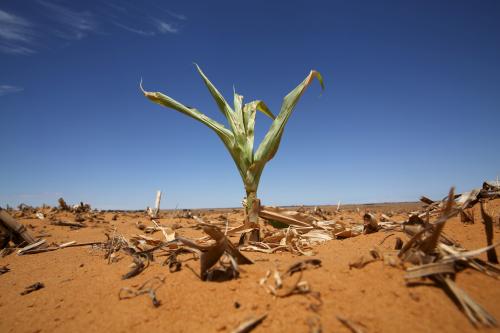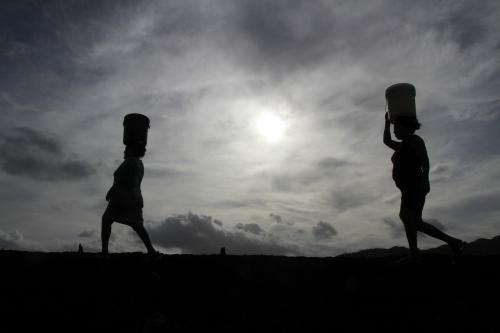October 16 is World Food Day 2018. It celebrates the founding of the United Nations’ Food and Agriculture Organization 73 years ago.
This U.N.-sponsored “day” is an opportunity to reflect on the fact that millions still suffer from food insecurity. People and governments everywhere believe that in a world of plenty, where average incomes are approaching $18,000 (PPP), it is intolerable that human beings anywhere should be hungry. Therefore, governments of every country in the world have boldly declared that they will end hunger by 2030.
This global effort, enshrined as Sustainable Development Goal (SDG) 2, is already three years old. At the U.N. General Assembly in September 2019, world leaders will meet to check on the progress of the SDGs. It seems certain that the news on SDG 2 will be grim by virtually any measure. As of 2017, over 150 million children remain stunted, roughly 820 million people are undernourished (a number that has increased for each of the last three years), and over 2.5 billion people responded that they lacked the resources needed to buy food at some point in the last 12 months, again a sharp increase.
Figure 1: Three dimensions of hunger, 2000-2017
Why is this happening and what can be done about it?
1. Technology
For all the efforts to catalyze a second green revolution using technology, the results for staple crop yields speak for themselves. As shown in Figure 2, sub-Saharan Africa lags far behind the other regions. Not only are yields in Africa the lowest in the world, but they have also had the smallest increases. Unlike in manufacturing, where catch-up technology has helped almost all countries, there are no signs of this happening in agriculture.
Without yields of at least 2 metric tons/hectare, smallholder farmers cannot generate any surplus to reinvest in their lands—they have a hand-to-mouth existence. Sub-Saharan African farmers use just over one-tenth of the average global fertilizer consumption. They face issues of water, with frequent drought and little irrigation. They lack power to till the land and harvest and store crops efficiently. Unless yields can be raised for millions of smallholder farmers on the continent, there will be little hope of making progress on ending hunger. This is why the Bill & Melinda Gates Foundation, with other partners, is doubling down on a new agriculture data initiative to help smallholder farmers in South Asia and Africa, and to focus policymaker attention on their situation.
Figure 2: Cereal yield by region
2. Coherent Policy
Smallholder farmers depend on their own countries’ policy framework, including property rights, safety nets, rural investment climate, agricultural extension support, and market development. These policies, in turn, respond to global market conditions where, unfortunately, agriculture remains highly distorted and potential benefits from trade are significantly underexploited. Figure 3 shows the subsidies for domestic agricultural producers by OECD countries and China. Though the decrease in levels for OECD countries over the last decades is commendable, the absolute level of producer support subsidies still distorts global markets, hurting smallholder producers. Since 2000, China has also been ramping up its producer subsidies in an effort to reduce rural poverty there. China, too, is now reversing course, but together, the fact that the largest economies in the world intervene so strongly in agricultural markets is an obstacle to the global goal of ending hunger.
The Agricultural Incentives Consortium collects data on government policies. A summary statistic—the nominal rate of protection for the agricultural sector—has been trending upwards since the food price crisis of 2008. Governments justify these measures by claiming they are needed to ensure domestic food security and a healthy rural economy, but the experiences of countries such as Australia and New Zealand, that have virtually eliminated tariffs on agricultural products, provide a model for how agricultural trade policy can be designed to promote national and global development. Unless more countries, especially the largest, follow suit, ending global hunger will be a challenge.
Figure 3: Policy distortions on global agriculture—Producer support estimates in large economies
3. Political Economy
A source of frustration for advocates working to end global hunger is the low prioritization of Food and Nutrition Security (FNS) within the crowded space of development aid. There is a clear tendency for aid to be reactive, not strategic. When there are headline-grabbing famines and/or global food price shocks, aid for food and nutrition security goes up. When food prices subside and the crisis is off the front pages, aid declines (Figure 4). Breaking this cycle and creating long-term funding sources for food security will be key to bringing to scale the needed interventions.
Figure 4: Donor aid commitments for food and nutrition security track global food prices
Organizing thinking around FNS interventions
If the world is to achieve SDG 2 and end hunger by 2030, we must focus on outcomes, policies to raise yields and build efficient and inclusive markets, and on public and private investments needed to achieve these outcomes. Our Ending Rural Hunger project is one effort to organize the often bewildering array of data surrounding FNS around a framework of needs, policies, and resources. Analyzing a country’s needs allows us to diagnose priorities and interlinkages between poverty, undernourishment, smallholder yields, and exposure to shocks. Examining a country’s policies allows us to identify gaps in safety nets, market incentives, regulations, and infrastructure. Understanding a country’s resources will reveal the domestic and external financial commitments that a country can marshal to achieve SDG 2.
The world has a lot of work to do in order to achieve Agenda 2030. Looking seriously, country by country, at needs, policies, and resources is the only way to work towards better policies and greater, as well as smarter, resource allocation.











Commentary
World Food Day 2018: The elusive quest to end hunger
October 16, 2018